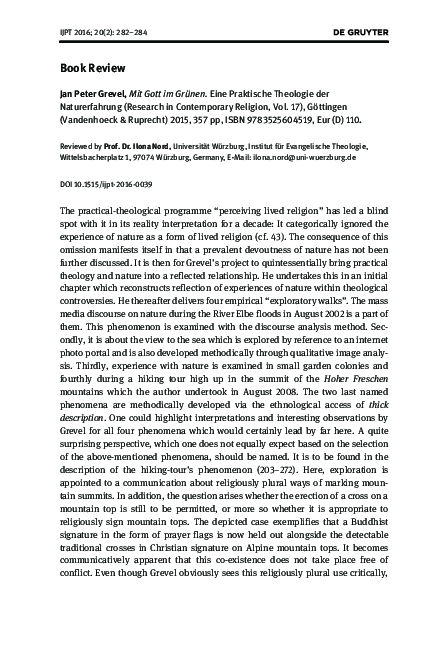Academia.edu no longer supports Internet Explorer.
To browse Academia.edu and the wider internet faster and more securely, please take a few seconds to upgrade your browser.
Theologie im Dialog mit dem Zeitverständnis der Naturwissenschaften
Theologie im Dialog mit dem Zeitverständnis der Naturwissenschaften
2020, Berliner Theologische Zeitschrift
Zusammenfassung Ein einflussreiches kontinentales Dialogmodell im Gespräch von Theologie und Naturwissenschaften liegt in der Diskussion um ein angemessenes Zeitverständnis. Während die klassische Physik (Newton) nur eine Zeit der ewigen Gegenwart kannte, hat die neuere Physik (z. B. in der Thermodynamik) die Bedeutung des Zeitpfeils erkannt. Die Evolutionsbiologie verdankt sich dieser linearen Zeitperspektive geradezu. Es verbleiben jedoch immer noch denkbare Zeitdimensionen, die anderen Bereichen der Wirklichkeit als den naturwissenschaftlich erfassbaren zugeordnet werden können.
Related Papers
Logical Empiricism and the Physical Sciences: From Philosophy of Nature to Philosophy of Physics
Introduction: From Philosophy of Nature to Philosophy of Physics2021 •
Journal for General Philosophy of Science
Towards an evolutionary pragmatics of science1985 •
Fundamentismus (“Foundationism”) und Skeptizismus-Anarchismus sind zwei entgegengesetzte Positionen in der traditionellen Erkenntnistheorie und in der modernen Wissenschaftstheorie. Zwischen ihnen gibt es einen dritten Standpunkt, den Evolutionismus. Beispiele sind zwei neuere Arbeiten von Putnam (1978) und Stegmüller (1979). Im Gegensatz zum logisch-statischen Fundamentismus berücksichtigt der Evolutionismus auch dynamische und naturalistische Ansätze. Stegmüller folgend entlehnen wir in der vorliegenden Untersuchung aus der Sprachphilosophie pragmatische Gesichtspunkte, um die logische Syntax und Semantik, die Werkzeuge des Fundamentismus, zu ersetzen. Wir zeigen die Kraft der Pragmatik bei der Behandlung von Problemen wie Erkenntniswachstum, Begriffswechsel, Theorien- und Bedeutungsdynamik, wissenschaftliche Entdeckung und besonders beim Problem der Inkommensurabilität. Unser nicht-fundamentistischer Vorschlag ist ein heuristisches Modell, das auf der modernen genetischen Theorie basiert.
1995 •
Abstract. The recently suggested reformulation of Darwinian evolutionary theory, based on the thermodynamics of self-organizing processes, has strong philosophical implications. My claim is that the main philosophical merit of the thermodynamic approach, made especially clear in J.S. Wicken's work, is its insistence on the law-governed, continuous nature of evolution. I attempt to substantiate this claim following a historical analysis of beginning-of-the-century ideas on evolution and matter-life relationship, in particular, the fitness-of-the-environment-for-life theory of the Harvard physiologist L.J. Henderson. In addition, I point to an epistemological common ground underlying the studies of the “thermodynamics school” and other currently active research groups focusing on the emergence and evolution of biological organization.
Zenker, F. and Gärdenfors, P. (eds.) (2015). Applications of Conceptual SpacesApplications of Conceptual Spaces (pp 259-277). Dordrecht: Springer.
Communication, Rationality, and Conceptual Changes in Scientific Theories2015 •
This article outlines how conceptual spaces theory applies to modeling changes of scientific frameworks when these are treated as spatial structures rather than as linguistic entities. The theory is briefly introduced and five types of changes are presented. It is then contrasted with Michael Friedman’s neo-Kantian account that seeks to render Kuhn’s “paradigm shift” as a communicatively rational historical event of conceptual development in the sciences. Like Friedman, we refer to the transition from Newtonian to relativistic mechanics as an example of “deep conceptual change.” But we take the communicative rationality of radical conceptual change to be available prior to the philosophical meta-paradigms that Friedman deems indispensable for this purpose.
Studies in History and Philosophy of Modern Physics
Brigitte Falkenburg, Editor, Between rationalism and empiricism. Selected Papers in the Philosophy of Physics; Erhard Scheibe, Springer, Berlin (2001) ISBN 0-387-98520-4 (627pp. Euro 88.76)2005 •
There is a need to bring about a revolution in the philosophy of science, interpreted to be both the academic discipline, and the official view of the aims and methods of science upheld by the scientific community. At present both are dominated by the view that in science theories are chosen on the basis of empirical considerations alone, nothing being permanently accepted as a part of scientific knowledge independently of evidence. Biasing choice of theory in the direction of simplicity, unity or explanatory power does not permanently commit science to the thesis that nature is simple or unified. This current "paradigm" is, I argue, untenable. We need a new paradigm, which acknowledges that science makes a hierarchy of metaphysical assumptions concerning the comprehensibility and knowability of the universe, theories being chosen partly on the basis of compatibility with these assumptions. Eleven arguments are given for favouring this new "paradigm" over the current one.
RELATED PAPERS
Marchitelli, Mascitti e la musica strumentale napoletana fra Sei e Settecento
I Passagagli di Francone per violoncello: una scuola di diminuzione virtuosistica napoletana a fine Seicento2023 •
Cuadernos de Economía
Formality and informality in an emerging economy: the case of Colombia2024 •
Academy of Management Proceedings
Constructing Algorithms for Forecasting High (Low) Project Management Performance2019 •
Social Science Research Network
The Prevalence of Multimorbidity and Associations With Clinical Outcomes Among Middle Aged People in Golestan, Iran: A Longitudinal Cohort Study2021 •
International Journal of Social Sciences and Humanities Research
AFRICAN RESPONSES TO THE COVID-19 PANDEMIC: ABSENT PRESENCES OR PRESENT ABSENCES2020 •
European Journal of Pharmacology
Subchronic lithium treatment increases the anxiolytic-like effect of mirtazapine on the expression of contextual conditioned fear2014 •
2007 •
International Journal of Primatology
Is Malaysia’s “mystery monkey” a hybrid between Nasalis larvatus and Trachypithecus cristatus? An assessment of photographs2023 •
Medicine & Science in Sports & Exercise
Cardiorespiratory Fitness, Physical Activity Levels and Sedentary Behaviour in College Students2016 •

 Andreas Losch
Andreas Losch